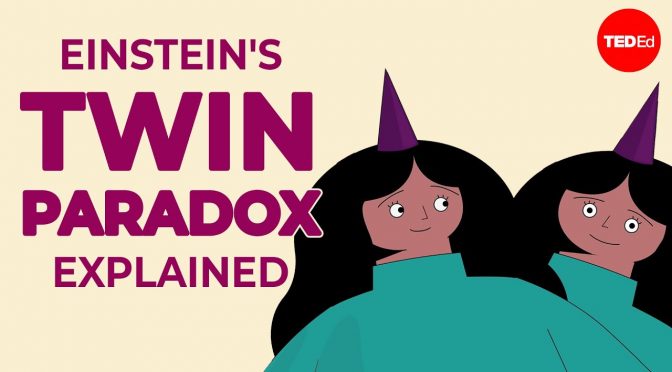Based on the video titled “Einstein’s twin paradox explained” by Amber Stuver on TED-Ed, this article delves into the intriguing concept of time dilation and Einstein’s theory of relativity through the Twin Paradox thought experiment. The video provides a comprehensive explanation of the Twin Paradox, a thought experiment in physics that involves a pair of twins who undertake different journeys and experience time differently.
Contents
- The Experiment
- The Lorentz Factor and Time Dilation
- The Twin Paradox
- The Light Burst Experiment
- The Asymmetry of Aging
- The Inertial Observer Misconception
- The Outcome
- Further Studies and Thoughts
- The video
The Experiment
The experiment involves identical twin astronauts, Terra and Stella. On their 20th birthday, Terra stays on Earth, while Stella embarks on a space journey at 86.6% the speed of light to a star 10 light-years away and then returns to Earth at the same speed. The twins, having studied special relativity, anticipate that their reunion might not be as simple as it seems.
The Lorentz Factor and Time Dilation
The Lorentz factor, a concept in special relativity, quantifies the relationship between the speed of an object and the passage of time. As an object moves faster through space, it moves slower through time compared to a stationary observer. At 86.6% of the speed of light, the Lorentz factor is 2, meaning time will pass twice as slowly aboard Stella’s spaceship. However, Stella won’t notice this time dilation, as all time-based processes on the ship, including her biological activities and perception of time, will slow down in sync.
The Twin Paradox
The Twin Paradox arises from the twins’ differing perspectives. From Terra’s viewpoint on Earth, she will age faster than Stella. However, Stella argues that from her perspective, it’s the universe, including Terra, that’s moving, making Terra age slower. This contradiction, where each twin believes they will be the older one upon reunion, is the crux of the Twin Paradox.
The Light Burst Experiment
To test their theories, the twins agree to send a burst of light to each other every time a year passes for them. The speed of light remains constant, regardless of the observer’s reference frame. Therefore, when one twin observes a burst of light, they’re measuring how long it took for the other twin to experience a year, plus the time it took for the light to travel between them.
The Asymmetry of Aging
Throughout Stella’s journey, Terra observes Stella aging slowly for about 90% of their 23 years apart and aging rapidly during the last 10%. This asymmetry resolves the paradox. Although each twin witnesses time both speeding up and slowing down for the other, Stella sees an even split, while Terra sees Stella aging slowly for most of the time they’re apart.
The Inertial Observer Misconception
Stella’s assumption that she and Terra had equal claim to being inertial observers was incorrect. An inertial observer maintains a constant speed and direction relative to the rest of the universe. Terra, being at rest the entire time, had a constant velocity of zero. However, Stella, who changed her direction for the return journey, entered a different reference frame from the one she’d started in.
The Outcome
When the twins are reunited, Terra is 43 years old, while Stella is 31, making them a perfect example of special relativity. This experiment underscores the fascinating workings of spacetime and provides a tangible understanding of Einstein’s theory of relativity.
Further Studies and Thoughts
The Twin Paradox has been a subject of numerous studies and discussions. A Scientific American article explains how relativity theory resolves the Twin Paradox. It emphasizes that the paradox is not a contradiction but a demonstration of how time dilation works in special relativity.
An article on Space.com delves into what it means for time to be relative, using the Twin Paradox as an example. It further elaborates on the concept of time dilation and how it affects the twins’ aging process.
A study on ResearchGate points out that a complete resolution of the Twin Paradox requires considering the gravitational effect on the rate of time passage. This perspective adds another layer of complexity to the paradox, emphasizing the intricate nature of spacetime.

